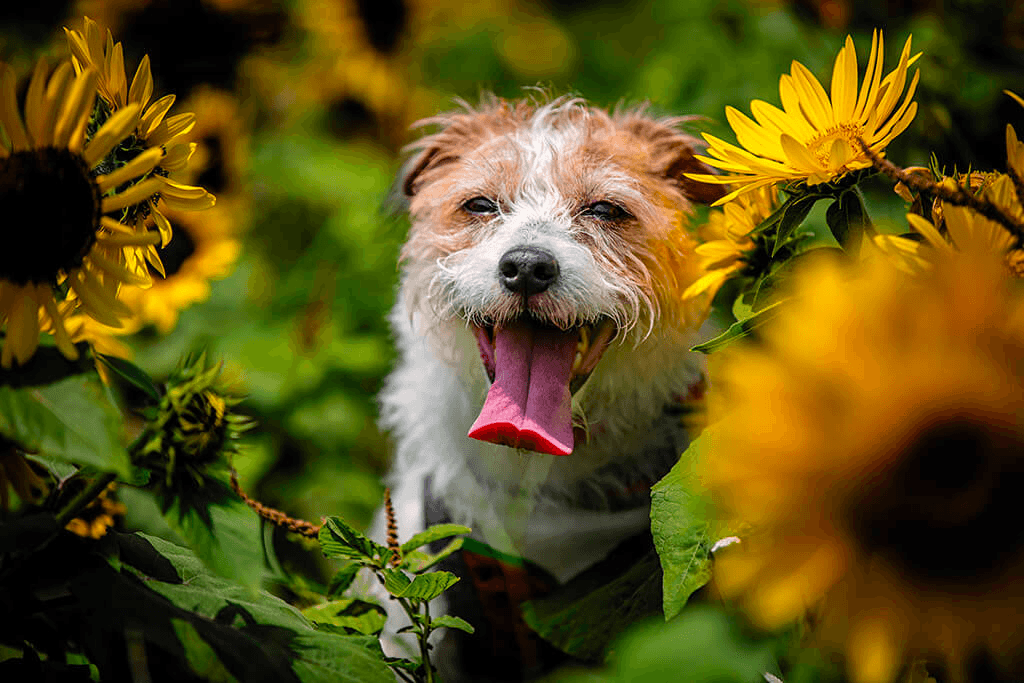If your dog is itching, licking, or experiencing hair loss, common skin issues may be to blame. Find out which skin issues impact dogs and how you can help.
- Home/
- Dog/
- Health & Wellness/
- Dog Skin Problems: How to Identify & Prevent Common Issues
Dog Skin Problems: How to Identify & Prevent Common Issues

Is your dog constantly scratching, licking, or losing patches of fur? This type of behavior is often linked with dog skin problems, and it’s something that a lot of our canine companions struggle with on a day-to-day basis.
Skin issues in dogs can be caused by a number of things, and the treatments vary depending on what’s behind it.
In this article, we will dive into the most common dog skin problems, talk about their causes, and suggest how to prevent and treat them.
Allergies
1. Environmental Allergies
Also known as atopy, this category of allergies is the direct result of a dog’s immune system overreacting to common airborne allergens. Some common allergy triggers in dogs include dust mites, mold, or even regular grass.
Some of the more common symptoms include constant itching (especially around the face, paws, or belly area), red or inflamed skin, excessive licking of the paws, and chronic ear infections.
Unfortunately, these types of allergies cannot be cured, but that doesn’t mean your dog can’t lead a comfortable life. Symptoms of environmental allergies can be managed with antihistamines, immunotherapy, hypoallergenic shampoos, and managing your dog’s environment.
2. Food Allergies
Food allergies in dogs may impact a dog’s digestive health and pups with food allergies may display symptoms such as diarrhea, bloating, and gas. But food allergies can also have a big impact on the health of your dog’s skin.
For example, foods like beef, chicken, dairy, eggs, or soy can trigger an allergic reaction in your dog that manifests on their skin. In fact, it is more common for dogs to be allergic to the proteins in their foods than to grains.
Dermal signs of food allergies are similar to those triggered by the environment, but they are often accompanied by digestive issues such as vomiting or diarrhea, as well.
The tricky thing about dog food allergies is figuring out exactly which ingredient is causing the problem. The standard for determining what is causing your dog’s food allergy is to perform an elimination diet. For an elimination diet, your dog is fed an allergy diet, usually a prescription food, for around 8 weeks. During this time, the dog can only eat the allergy food, meaning no other treats or flavored medications can be given. If the symptoms improve during this diet trial, then previous ingredients are slowly added back to the dog’s diet to determine what causes the allergic reaction.
Blood and skin allergy testing are not shown to be reliable for determining food allergies in dogs.
Dogs with food allergies commonly remain on an allergy food long-term.
3. Flea Allergy Dermatitis
Fleas are annoying to any dog, but some canines can be hypersensitive to their saliva, which can lead to skin issues.
This hypersensitivity is called flea allergy dermatitis (FAD), and its signs include itching and hair loss, inflamed skin, scabs and sores, as well as general restlessness in your dog. The bite of only one flea can cause an extreme allergic reaction in the dog’s skin.
Keeping your dog on a monthly flea preventative year-round can help your dog stay flea free.
Inflamed Areas
4. Hot Spots
If you wake up one day and notice a red, oozing sore on your dog’s skin it could be a hot spot.
They are essentially inflamed patches of skin caused by insect bites, allergies, or other irritants that cause dogs to lick or bite at their skin. This causes irritation and can lead to infections. Hot spots can be very itchy and painful for your pet.
Treating hot spots on dogs involves keeping the area clean and dry and preventing your dog from biting or licking the area. Your veterinarian may also recommend an antiseptic solution or a topical medication. Remember to only use products that have been cleared by the vet.
In order to prevent more hot spots from developing, it’s important to address the original cause of your dog’s discomfort that prompted them to bite and lick.
Infections
5. Pyoderma
This bacterial skin infection usually affects dogs that already have another underlying health problem, such as allergies, or open wounds.
You can usually recognize it by puss-filled bumps on your dog’s body that almost look like human pimples, surrounded by patches of lost hair. You may also notice a foul odor from the skin.
If you notice something like this in your dog, the best course of action is to take them to the vet. A veterinarian will usually prescribe antibiotics and possibly suggest medical shampoos with antibacterial properties.
6. Yeast Dermatitis
Yeast dermatitis, also called Malassezia dermatitis, is a fungal skin infection caused by the yeast Malassezia pachydermatis. While this specific yeast is a normal part of a dog’s skin biota, an overgrowth can result in yeast dermatitis. Most dogs that develop a skin infection caused by yeast have an underlying skin or endocrine health issue, such as allergies or Cushing’s disease.
Signs include a yeasty/musty odor, itchiness, redness, thickened skin (i.e. lichenification), and dark pigmentation. Dogs may also get yeasty ear infections.
Treatment may include antifungal shampoos, oral medications like terbinafine or itraconazole, and ointments. If the dog has an underlying condition making them prone to yeast dermatitis, this condition will also need to be managed.
7. Ringworm
Although it’s called ringworm, this infection is actually caused by a type of fungus. It most often results from direct contact with another infected animal or a contaminated object, such as a blanket.
Ringworm can wreak havoc on a dog’s skin. It causes red, scaly areas and may lead to hair loss and secondary skin infections.
For treatment, veterinarians often recommend antifungal creams and oral medications. It’s also important to disinfect your dog’s living and sleeping areas to kill the fungal spores that cause ringworm. Because ringworm is contagious to people and to other dogs, your dog may have to be isolated for a period of time to prevent the spread to other pets or to people.
Parasites
8. Fleas and Ticks
Fleas and ticks latch onto your dog’s skin, feed on their blood, and contribute absolutely nothing. They are the ultimate freeloaders.
When it comes to dog skin problems caused by these tiny, frustrating creatures, bites can cause intense itchiness, even in dogs who do not have FAD. The sensation of these parasites crawling around in the dog’s fur may cause scratching or chewing that can result in infections, wounds, and hot spots. The bites of these parasites can also become infected, causing discomfort.
It’s important to regularly and thoroughly check your dog for parasites and keep them on monthly parasite prevention.
9. Mites
Mites are microscopic parasites that burrow into a dog’s skin, causing a condition known as mange. There are two main types of mange, each with distinct causes and symptoms.
Demodectic mange most often affects young puppies whose immune systems haven’t yet matured. It’s not too itchy, but it can lead to patches of fur loss, especially on the face and around the eyes.
Sarcoptic mange, on the other hand, is highly contagious to both dogs and humans. It’s intensely itchy, causes severe hair loss, and often results in excessive scabbing on the skin from all the scratching.
Mange is normally treated by veterinarians with specific antiparasitic medications like ivermectin, selamectin, or fluralaner. They may also recommend medicated shampoos or topical treatments. In the case of scabies, prolonged quarantine might be needed to prevent the rapid spread of the mites to other animals and people.
In the end, the key to keeping our dog’s skin healthy is early detection and consistent parasite prevention. If you get the feeling that something is off, don’t hesitate to reach out to your vet as soon as possible.
Other Skin Conditions
While we’ve covered some of the most common skin conditions that affect dogs, pet parents should note that this list is not all-inclusive. Other conditions, such as burn injuries, autoimmune conditions, cancers, and benign growths can cause skin issues in dogs.
How to Take Care of Your Dog’s Skin
While not all dog skin problems can be prevented, there are steps you can take to keep your canine’s skin and coat healthy.
Keep up with grooming and hygiene. While you don’t want to over bathe your dog, keeping them free of dirt and grime can help prevent skin irritation and infections. Wipe down your dog’s paws after being outdoors, keep their hair trimmed, and brush your dog’s coat regularly to prevent mats and check for skin abnormalities.
Use monthly parasite prevention. As mentioned, parasites like fleas and mites can lead to dog skin problems. Using a vet-approved monthly parasite medication can help keep your dog free from these unwelcome pests.
Focus on hydration. Make sure your dog drinks plenty of water to maintain adequate hydration. Dehydration in dogs can cause dry, cracked skin, which is more susceptible to damage and irritation.
Manage allergies. If left untreated, allergies can quickly turn into bigger skin dog skin problems. Working with your veterinarian to identify allergy triggers, keeping your dog’s environment clean, and discussing different treatment options can help keep your pup’s allergy symptoms at bay.
Feed a complete and balanced diet. Skin health in dogs is linked to nutrition. Make sure your pup is eating a complete and balanced diet that meets the standards of the Association of American Feed Control Officials (AAFCO). These dog foods will ensure your dog is getting the nutrients they need.
 D
D




